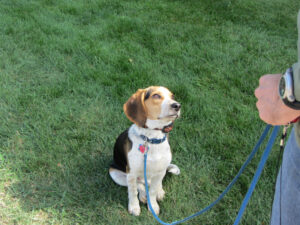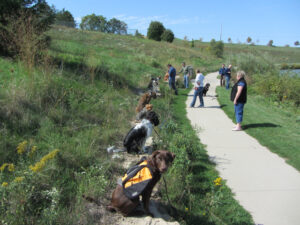That is a question a lot of people ask, including other Dog Trainers. Using the tool effectively, at a low level to gain and retain a dogs attention is not something everyone intuitively understands, which is why there is such a need for education.
Here at That’s My Dog! one of my responsibilities is to oversee our Professional Trainers remote collar course. The final session for the year started this week and it is always fun to meet new friends from around the globe who are curious to learn more about the varied applications of electronic collars.
Typically our class profile is comprised of both experienced and novice trainers and this group is no different. We are even pleased to have a graduate of Karen Pryor’s clicker training academy joining us. The diversity makes for good conversation and gives us reason to challenge each others thoughts and opinions to expand our skills even further.
This week we are working on the basics: how to figure out the Just Right level, how to assist the dog in understanding what the stimulation means and have control over it through various obedience skills such as coming when called, staying in one place or walking nicely on a loose leash. We’re also covering the wide variety of ways to keep both the dogs and their owners motivated and engaged in the dog training process.
On Wednesday there was even a nice outing to the park that helped sum up exactly what the primary goal of remote collar training is: giving dog owners a high level of reliability in real world environments so they can confidently do more with their dogs. We went for a walk, helped the dogs learn good manners in public and then shared lunch together. The dogs had a great time and I think the humans enjoyed it just as much!
While there has always been a wide variety of people attracted to this program, the overall theme seems to be that it draws individuals who have open minds and a willingness to explore new things. In my opinion that is the biggest key to success for a trainer who wishes to help all sorts of people and their dogs. As the years of teaching the TMD E-cademy have gone by, I’m pleased to have played at least a small part in the experience of so many trainers. Many who have gone on to build extraordinary businesses, become articulate writers and educators or some who have started non-profit programs that are filling a void. Collectively they’ve train tens of thousands of dogs and made an impact on the lives of many who needed help to develop a better relationship with their dog.
So far it’s been a great week and we’re looking forward to more in the coming days.


I have been using an e-collar on my dog for about 1 year now. He’s a lagotto romagnolo with very high prey drive. I use it mainly to walk him off leash and keep him off rabbits which are plentiful where we live. That being said, I still can’t get him to walk nicely on a loose leash. I really have to stay on the collar to get him to mind and I don’t think that is how it should be. I have worked with sit-means-sit and their philosophy is to tap or “lay on the collar” whenever he gets ahead of me. It just doesn’t seem right. I am looking for another opinion and help on this. Thank you!
Hi Liz,
It is a challenging thing for me to describe in writing, but you have to be very clear to your dog that Heel is a position so get clear in your mind exactly where you want your dog to be in relationship to you. Define that area, then you use the collar to tap when he gets outside that zone. BUT that is only half of the equation. You have to reward the dog for being in the zone. In the beginning I use a lot of food for my rewards. I want the dog to know initially that pay checks arrive when he is in that zone. I wean back quickly on how frequently I use them but my dogs learn to want to pay attention to being in that area because they know good things might happen. If your dog is prey driven you might also have good luck using toys or tug (but this can be a little slower only because you have to spend a few moments more allowing him to play with the reward). You also have to make sure you are helping the dog to ‘be in the zone’ this involves changes in your direction of movement that help him get back into that space. If you are just trying to walk in a straight line, you will have better luck if you work by turning 90 and 180 degree turns and figure 8’s. This helps the dog learn to focus. It is too easy for them to simply tune out in the beginning of you just go in a line. Sometimes I also incorporate other tools. A head halter or high placed slip collar can help to guide a strong dog into position. It is generally needed only temporarily, but gives you the advantage needed to help him learn the proper position. Hopefully some of these tips help.
I emailed you on your business site but Didn’t know you had a DVD introducing the use of the e-collar. What is it called & where can I find it? Thanks!
Hi Stephanie,
Yes, I do have 2 dvd’s available. You can find them here:
http://www.thatsmydogstore.com/SearchResults.asp?Cat=86
Hi Robin. I have to say that I love my remote collar. I have decided to take what may come as far as who looks down on me because not many people can say their 14 week old puppy can sit, stay, come, down, turn in a circle, and go under my legs as well as fetch and actually bring the ball back and give it to you! Of course my dog is still young and she still puppy bites terribly, but compared to friends I have who have puppies the same age, well the comparison is unreal. Some people might say that my dog only complies because she is afraid. Well she listens when she doesnt wear the collar as well. Also my dog is not a “soft dog” ….the first time I took her to the vet they said…”you are really going to have to work with this one.” Well she was right, even with the collar I have spent a minimum of 30 minutes a day training and usually over an hour. When I first got her I was going to try all clicker training. Well that was great until I was out of treats and then she would blow me off. I still use the clicker because its fun for her, but for reliability I use the collar. I have had so much fun with my puppy while friends I have who also have puppies are just pulling their hair out waiting for the puppy stage to end. I would love to take one of your seminars or workshops for training. I have so much fun training I would love to improve and maybe one day help others with their dogs. My parents are visiting and they just cannot believe the amount of reliability I have with my puppy and the variety of commands she knows for her age. Thank you for your wonderful blog! I love reading all of the information you give and learning more about training!
Thank you Bex. I’m glad the blog has been helpful and thrilled to hear you are having such a lovely time raising and training your pup. That is how it should be! Fun and learning together. 🙂
For anyone considering attending TMD trainer’s programs, I simply say, “Do it!” You’ll be glad you did. Their training programs and staff are outstanding. Robin helped me to take my business to the next level, and then to the next level, etc. etc She is a great educator of dogs and people!
Thanks Michael! I love helping dogs and people improve their lot in life. There is so much more for all of us to achieve!